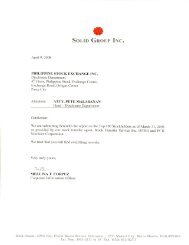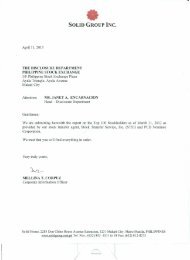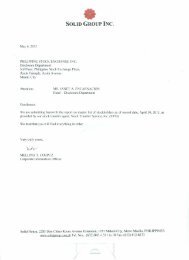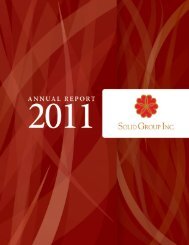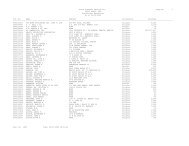SEC Form 17-A: Annual Report - the solid group inc website
SEC Form 17-A: Annual Report - the solid group inc website
SEC Form 17-A: Annual Report - the solid group inc website
You also want an ePaper? Increase the reach of your titles
YUMPU automatically turns print PDFs into web optimized ePapers that Google loves.
- 9 -<br />
(vii) PAS 32 (Amendment), Financial Instruments: Presentation – Offsetting Financial<br />
Assets and Financial Liabilities (effective from January 1, 2014). The<br />
amendment provides guidance to address <strong>inc</strong>onsistencies in applying <strong>the</strong><br />
criteria for offsetting financial assets and financial liabilities. It clarifies that a<br />
right of set-off is required to be legally enforceable, in <strong>the</strong> normal course of<br />
business, in <strong>the</strong> event of default and in <strong>the</strong> event of insolvency or bankruptcy<br />
of <strong>the</strong> entity and all of <strong>the</strong> counterparties. The amendment also clarifies <strong>the</strong><br />
pr<strong>inc</strong>iple behind net settlement and <strong>inc</strong>ludes an example of a gross settlement<br />
system with characteristics that would satisfy <strong>the</strong> criterion for net settlement.<br />
The Group does not expect this amendment to have a significant impact on<br />
its con<strong>solid</strong>ated financial statements.<br />
(viii) PFRS 9, Financial Instruments: Clarification and Measurement (effective from<br />
January 1, 2015). This is <strong>the</strong> first part of a new standard on classification and<br />
measurement of financial assets and financial liabilities that will replace<br />
PAS 39, Financial Instruments: Recognition and Measurement in its entirety. This<br />
chapter deals with two measurement categories for financial assets: amortized<br />
cost and fair value. All equity instruments will be measured at fair value while<br />
debt instruments will be measured at amortized cost only if <strong>the</strong> entity is<br />
holding it to collect contractual cash flows which represent payment of<br />
pr<strong>inc</strong>ipal and interest. The accounting for embedded derivatives in host<br />
contracts that are financial assets is simplified by removing <strong>the</strong> requirement to<br />
consider whe<strong>the</strong>r or not <strong>the</strong>y are closely related, and, in most arrangements,<br />
do not require separation from <strong>the</strong> host contract.<br />
For liabilities, <strong>the</strong> standard retains most of <strong>the</strong> PAS 39 requirements which<br />
<strong>inc</strong>lude amortized-cost accounting for most financial liabilities, with<br />
bifurcation of embedded derivatives. The main change is that, in case where<br />
<strong>the</strong> fair value option is taken for financial liabilities, <strong>the</strong> part of a fair value<br />
change due to an entity’s own credit risk is recorded in o<strong>the</strong>r comprehensive<br />
<strong>inc</strong>ome ra<strong>the</strong>r than in profit or loss, unless this creates an accounting<br />
mismatch.<br />
To date, o<strong>the</strong>r chapters of PFRS 9 dealing with impairment methodology and<br />
hedge accounting are still being completed.<br />
Fur<strong>the</strong>r, in November 2011, <strong>the</strong> IASB tentatively decided to consider making<br />
limited modifications to IFRS 9’s financial asset classification model to<br />
address certain application issues.<br />
The Group does not expect to implement and adopt PFRS 9 until its effective<br />
date or until all chapters of this new standard have been published. In<br />
addition, management is currently assessing <strong>the</strong> impact of PFRS 9 on <strong>the</strong><br />
Group’s con<strong>solid</strong>ated financial statements and is committed to conduct a<br />
comprehensive study of <strong>the</strong> potential impact of this standard in <strong>the</strong> last<br />
quarter of 2014 before its adoption in 2015 to assess <strong>the</strong> impact of all changes.



